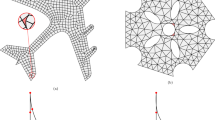Abstract
By the aid of the penalty function method, the equilibrium restriction conditions were introduced to the isoparametric hybrid finite element analysis, and the concrete application course of the penalty function method in three-dimensional isoparametric hybrid finite element was discussed. The separated penalty parameters method and the optimal hybrid element model with penalty balance were also presented. The penalty balance method can effectively refrain the parasitical stress on the premise of no additional degrees of freedom. The numeric experiment shows that the presented element not only is effective in improving greatly the numeric calculation precision of distorted grids but also has the universality.
Similar content being viewed by others
References
Pain T H H. Derivation of element stiffness matrices by assumed stress distribution[J].AIAA J, 1964,2(2): 1333–1336.
Pain T H H, Chen D P. Alternative ways for formulation of hybrid stress elements[J].Internat J Numer Meth Engrg, 1982,18(11): 1679–1684.
Pain T H H, Sumihara K. Rational approach for assumed stress finite elements[J].Internat J Numer Meth Engrg, 1984,20(9): 1685–1695.
Wu changchun, Di Shenglin, Huang Maoguang. Optimizing design of hybrid element[J].Chinese Science Bulletin, 1986,15(31): 1142–1144 (in Chinese).
Jiao Zhaoping. Penatly function method and its application in three-dimensional isoparametric hybrid element[J].Journal of Hefei University of Technology, 1991,14(1): 86–95 (in Chinese).
Jiao Zhaoping, Wu Changchun. Optimizing design of three-dimensional isoparametric hybrid element[J].Engineering Mechanics 1988,5(2): 10–20 (in Chinese).
Wu Changchun, Pain Xuehuang.Incompatible Numerical Analysis and Hybrid Element Method[M], Scientific and Technical Press, Beijing, 1997 (in Chinese).
Wu Changchun, Bufler H. Multivariable finite elements: consistency and optimization[J].Science in China, Ser A, 1991,34(2): 284–299.
Author information
Authors and Affiliations
Corresponding author
Additional information
Communicated by GU Yuan-xian
Rights and permissions
About this article
Cite this article
Dao-zheng, C., Zhao-ping, J. Application of penalty function method in isoparametric hybrid finite element analysis. Appl Math Mech 26, 1017–1025 (2005). https://doi.org/10.1007/BF02466414
Received:
Revised:
Issue Date:
DOI: https://doi.org/10.1007/BF02466414




